Demonstrative PronounsThe demonstrative pronouns are pronouns that are employed within a sentence to point towards something particular. These pronouns can refer to objects in space or time so that they can be either singular or plural pronouns. 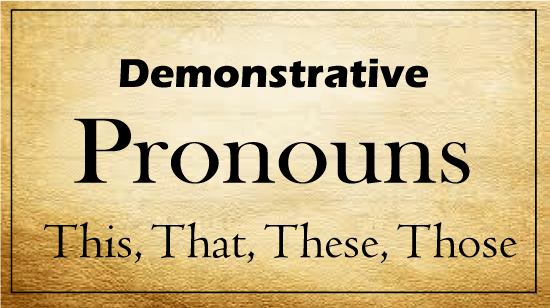
Individuals, animals, and things can all be addressed with demonstrative pronouns. As an example, People: This is my companion Lata. Animals: That appears to be a venomous snake. Objects: The automobiles in the front are more valuable than the ones in the back. The demonstrative pronouns can function as a subject as well as an object. Subject: I believe I require new boots. These are quite old. Object: What is that? 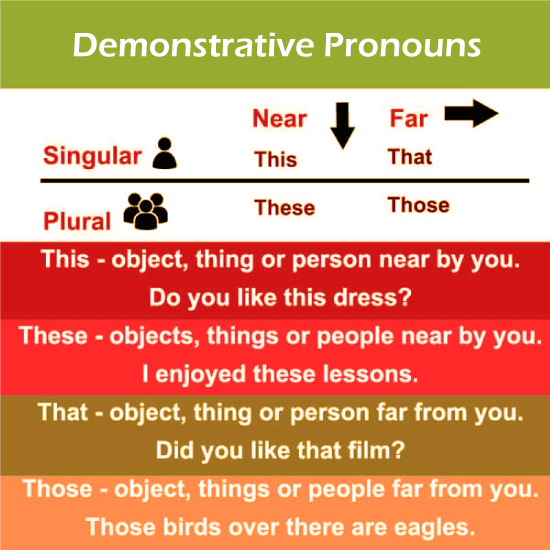
Demonstrative pronouns can be divided into being near or far in distance or time when employed to denote an item or items: Words This and these are used to denote close time or distance. Whereas words That, those who are used to refer to far in time or distance: Since English contains only a few demonstrative pronouns, there are only three easy principles in using them appropriately. Remember them, and you'll have no trouble using these unexpectedly intriguing elements of speech. Whether nouns are mentioned precisely, demonstrative pronouns always identify them. "I can't imagine it," for instance. We don't know what "this" is, but it's clearly something the author cannot imagine. It occurs, but we have no clue of what it is. 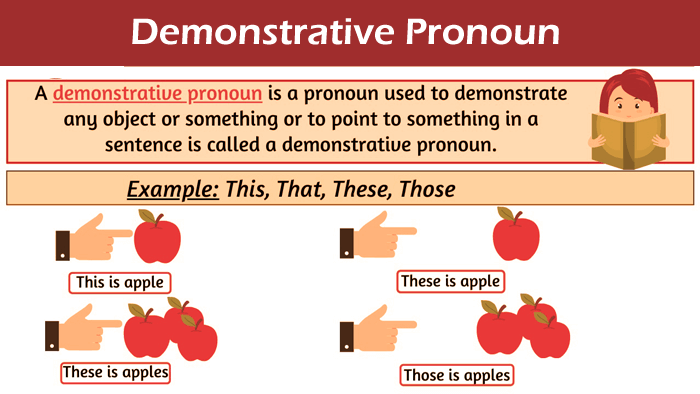
Demonstrative pronouns are generally employed to describe animals, locations, or objects. Still, they can also be utilized to describe individuals when the individual is identified, for example, "This seems like Martha singing." Demonstrative adjectives should not be mistaken with demonstrative pronouns. Although the terms are the same, demonstrative adjectives, qualify nouns while demonstrative pronouns exist independently. Demonstrative pronouns can be utilized in lieu of nouns as long as the noun being substituted is understandable from the context of the pronoun. Although this notion may appear to be a bit perplexing at first, the examples provided of demonstrative pronouns can help better understand the concept of demonstrative pronouns. Demonstrative Pronouns- ExamplesIn the below-mentioned instances, demonstrative pronouns have been bolded for easy recognition.
List of Demonstrative PronounsThese can be singular or plural Singular Demonstrative PronounsThe terms this and that are known as the singular demonstrative pronouns. They are used to allude to a single individual or entity. This is utilized to relate to things nearby, while that is used to allude to objects that are far away. However apart from being used as demonstrative pronouns, the term "that" has numerous other connotations and can be utilized as adjectives, adverbs, or conjunctions. For instance, the word can also be employed as a relative pronoun that initiates the relative phrases. 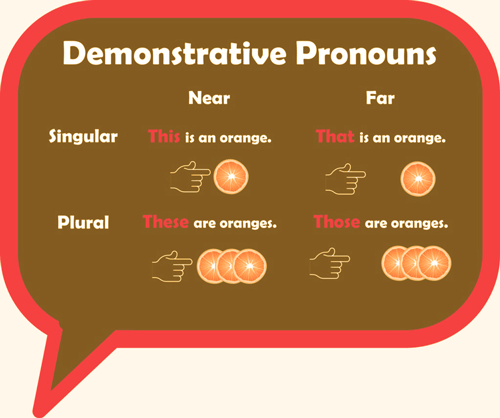
Plural Demonstrative PronounsThese and those are demonstrative pronouns in the plural. They are used to allude to more than one person or entities at the same timing. "These" is used to imply to things that are close by, whereas "those" is used to allude to things that are far away or distant. Demonstrative Pronouns Vs. Demonstrative AdjectivesLet us have a look at the distinction between demonstrative pronoun and demonstrative adjective All four terms, this, that, these, and those are demonstrative pronouns and demonstrative adjectives. The meanings of all four terms remain the same in spite of the part of speech they are often utilized in. Most of the times, utilizing a demonstrative pronoun or a demonstrative adjective does not affect the phrase's meaning. As an instance, Pronoun: There are a number of articles in my study room, but this is my personal fave. Adjective: There are a number of articles in my study room, but this article is my personal fave. Although the term this is employed as a pronoun in the first phrase, both statements have the same meaning. 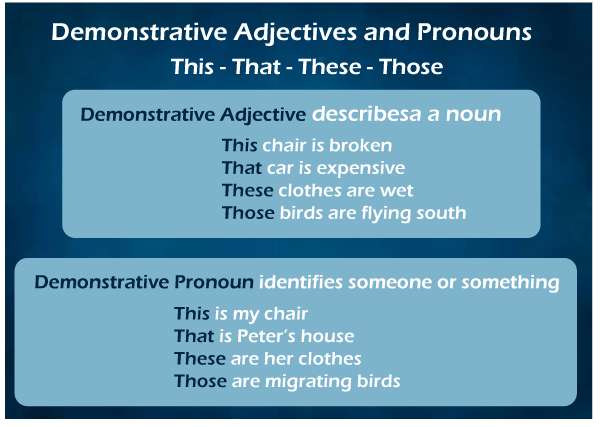
So, how can one tell if a term is the demonstrative pronouns or a demonstrative adjectives? A pronoun is often utilized in lieu of a noun, indicating that it is either a subject or an object. Pronouns do not change the meaning of other terms. An adjective, on the contrary, is utilized to alter nouns or pronouns. Conclusively, the term "that" in the following statement would be categorized as a demonstrative pronoun is: That appears to be enjoyable. (That is the sentence's subject.) It is employed as a demonstrative pronoun.) However, in the below-mentioned statement, that would be considered as a demonstrative adjective: That game appears to be enjoyable. (That is changing or altering the noun game.) It is a demonstrative adjective.) Usage Of Demonstrative PronounsLike most other pronouns, demonstrative pronouns must obey the same laws as nouns. This indicates they can act as a subject or an object and must adhere to subject-verb agreement. This and that utilize singular verb, but these and those utilize the plural verb: 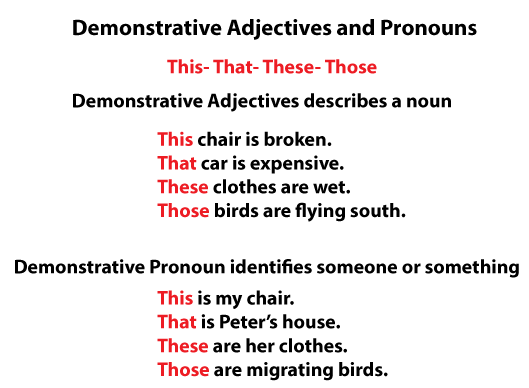
Correct: That is a costly SUV. Incorrect: That are a costly SUV. Correct: Those look tasty. Incorrect: Those looks tasty In general, it is critical to make it obvious to a reader or listener to whom a demonstrative pronoun refers. As an example, That is not a smart option, to put it mildly. (What is not a smart option?) More specifically, are you going to inform Jane that her singing is terrible? That is not a smart option. (Telling Jane that you dislike her singing is not a smart option.) We frequently employ demonstrative pronouns in ordinary discourse without specifying what they relate to. This is feasible since we can use our hands to indicate things or utilize context or body language to explain what we are saying. In some cases, there may be only one person or object in a location, in which case further elaboration is not required. You could, for example, say, "This is my new clothing," while referring to it with your finger. A listener can see at you and grasp what you're saying without any additional explanations or instructions.
Next TopicPersonal Pronouns
|
 For Videos Join Our Youtube Channel: Join Now
For Videos Join Our Youtube Channel: Join Now
Feedback
- Send your Feedback to [email protected]
Help Others, Please Share










